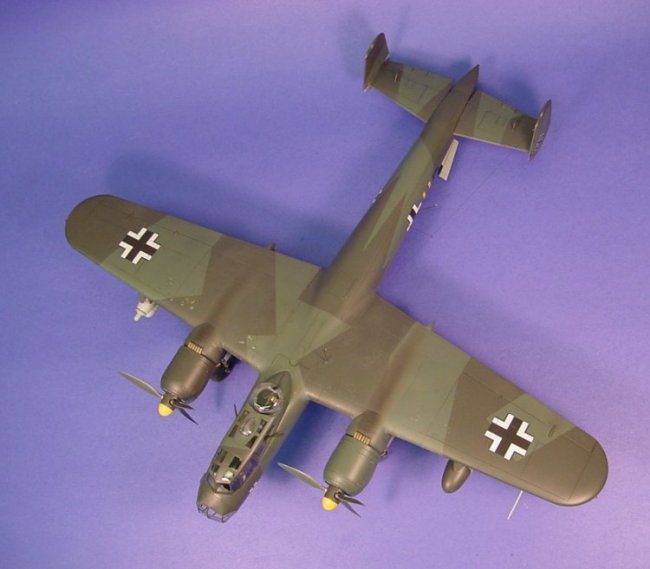 |
Biscay
Raider!
Photos by Steve
Bamford
--------------------
 |
Essentially evolved from the Dornier 17 and 215 series of aircraft, the Dornier Do-217 appeared in several different configurations during WWII. Like many of its Luftwaffe cousins, it served as a bomber, reconnaissance aircraft, nightfighter, torpedo bomber, destroyer, as well as a platform for the enigmatic guided glide weapons developed later in the war, such as the “Fritz X” and the Henschel Hs293. The Promodeller kit comes as one of the missile-carrying E-5’s.
| The kit comes in several sprues of grey styrene with finely engraved panel lines. The | |
| transparencies are crystal clear and the framing is very well defined, which makes masking them easy. The Hs293 glide weapon is particularly well molded, an impressive little model in itself! Markings come for two aircraft, both from II/KG100 based at Cognac, France, in August 1943. It was an Hs293 released by an aircraft from this unit that severely damaged the Canadian Tribal Class destroyer HMCS Athabascan (among other vessels) during the intense battles over the Bay of | |
| Biscay. | |
The interior as supplied in the kit is outstanding, with a high level of detail. The upper gun turret can be removed to see much of the interior. The only aftermarket items I added to the interior were some Reheat seatbelts and ammo belts from their Luftwaffe set.
| I separated the cowlings from the nacelles, as they are molded together in the kit. I replaced the kit exhausts with solder bent to shaped and assembled with superglue. | |
| Then I filled in the rear
of each cowling with plastic card discs and reassembled them to the
nacelles with short lengths of Evergreen tubing to give the rear of the
cowls some depth. The propeller spinners lacked the hole in the center,
which I drilled out with a pin vise. The fans on the spinner are a little
heavy, but I left them as is. All gun barrels were also drilled out.
The landing gear is very well done, but I was not happy with the main wheels, as they appear too narrow. The tread pattern is also suspect. Inserting a .010” disc between the wheel haves should fix this. I left mine as is, because I heard that True Details had just released a set of replacement wheels with bulged tires for this kit. Imagine my surprise when they were revealed to be merely direct copies of the kit wheels, in resin! Save your money… I ended up using the kit wheels, filling in the tread pattern as best I could and coating with Mr. Surfacer 500 to get a smoother looking tire. References for the Dornier 217 in the popular modelling press are surprisingly |
|
| scarce. The only source of any significance is the excellent Warpaint Series No.24, “Dornier 217”, by Jerry Scutts, with a very good set of drawings by Hubert Cance. | |
I painted the model with Floquil Military enamels, in the German maritime scheme of RLM 72 and 73 over 65. I lightened the RLM 73 with just a touch of white for a liitle more contrast between the colours. I preshaded the panel lines with dark gray, keeping the effect subtle. Decals are a mix of the kit decals, the Eagle Strike sheet for the Dornier 217, and home made ALPS printed decals, based on the photos and drawings in Scutts’ book. Weathering was a combination of drybrushing, oil washes, and pastel chalks. A few paint chips were sparingly applied with a silver pencil crayon. I tried to keep the weathering subdued, as I wanted to portray a fairly newly arrived machine, with just a few sorties under its belt (these aircraft had a relatively short life-span, anyway…).
 |
Will I build another? Since I
started this project, Koster Aero Enterprises has released two conversion sets,
one for a Do-217J or N nightfighter, and the Do-217K or M bomber versions: The
temptation may be too hard to resist…
Will